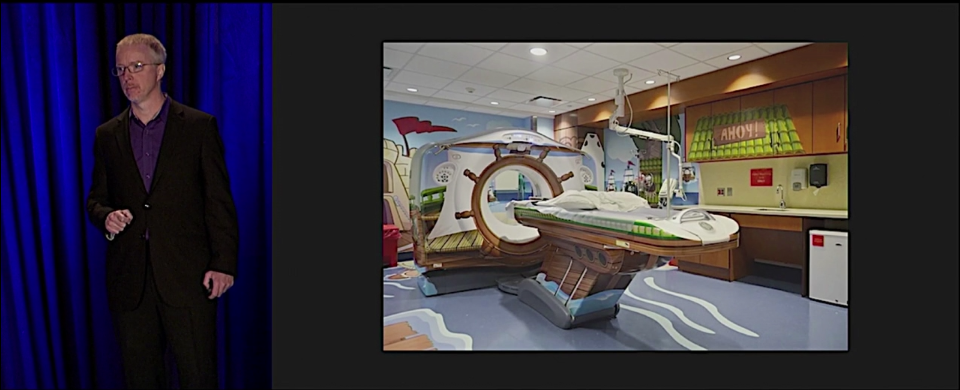Designing for Crisis, Design for Real Life
Published 9 years, 10 months pastBack in October of 2014, at An Event Apart Orlando, I returned to public speaking with “Designing for Crisis”, my first steps toward illuminating how and why design needs to consider more than just the usual use cases. I continued refining and delivering that talk throughout 2015, and it was recorded in October 2015 at An Event Apart Austin. As of late last week, you can see the entire talk for free.
There were a lot of strange confluences that went into that talk, some of them horrific, others just remarkable. One that stands out for me, as I look at that screenshot, is how a few years ago, Jared Spool gave a talk at AEA where he discussed the GE Adventure Series, in a segment that never failed to choke me up (and often choked up Jared). I remember being completely floored by that example, and at one point, based solely on what he’d said about the GE Adventure Series, I remarked to Jared that I occasionally thought about switching career tracks to become an experience designer.
Less than two years later, I stood in one of the first Adventure Series rooms at the University of Pittsburgh Medical Center, standing in the middle of a design I’d only ever seen on a projector screen, the same room you can see in the screenshot above, as my daughter’s head was scanned to see if the experimental medicine we’d been giving her had slowed her tumors.
Six months after that, I was talking about it on stage in Orlando, as an example of how designing for crisis can have spectacularly positive results. The video we released last week came a year later, and is a much better version of that first talk. I’m very happy that we can now share it with the world.
As I’ve said before, I came to realize that “Designing for Crisis” was just one piece of a larger puzzle. To start exploring and understanding the whole puzzle, I recently finished co-authoring Design for Real Life with Sara Wachter-Boettcher, to be published by A Book Apart, possibly as soon as March (but there’s not an official date yet, so that could change). In it, Sara and I explore a small set of principles to use in approaching design work, and talk about how to incorporate those principles into your existing design practice. The book is the foundation for a new talk I’ll be presenting at every An Event Apart in 2016 — including this year’s Special Edition show in Orlando.
As soon as the book is available for order, we’ll let everyone know — but for now, I hope you’ll find last year’s talk useful and enlightening. Several people have told me it changed the way they approach their work, and it serves as a pretty good introduction to the ideas and themes I’ve built on it for the book and this year’s talk, so I hope it will be an hour well spent.

Comments (7)
I am so grateful for having the chance to view this talk. What harsh irony about Jared’s presentation and your prescient thought about experience design. I continue to learn from you 20 years on…
I remember seeing the slide deck you mention of Jared’s, but couldn’t possibly understand the links drawn here to that lesson. Thank you so much for sharing all of this Eric. I echo others in stating how much your willingness to share has changed how I approach design, stress, and parenting.
I saw you give this talk in Orlando in 2014 and again in Chicago in 2015. I’m so glad it’s available now so I can share it with my team.
Will you be giving the new talk before Orlando this year or is that the first time? I might head to Boston for AEA this year!
It’ll be the same talk (with various updates and tweaks, as needed) throughout the whole year, Erin, including Boston. Hope to see you there!
Hello Eric,
I saw your presentation in 2014 and I appreciate you sharing it with the world. You’ve inspired a generation of usability & design professionals to test within more realistic terms – one of those is me.
Thanks,
Marc
Eric,
When I contacted you many years ago (about 12 years ago and yes, I purposely lost the phone # for you) about “getting the box model”, I never dreamed that the coding I was doing then would step up so far to be the coding I am doing today.
Since then, I have carefully read each book you have released so that I can try to keep up with your work. With each of your books I have the realization that you are certainly a code wizard! Thank you for helping me become a better coder (especially in CSS)! – Roberta
Pingback ::
CSS Animation, Prototyping Tools, and Sources of Inspiration, with Donovan Hutchinson — SitePoint
[…] Designing for crisis […]